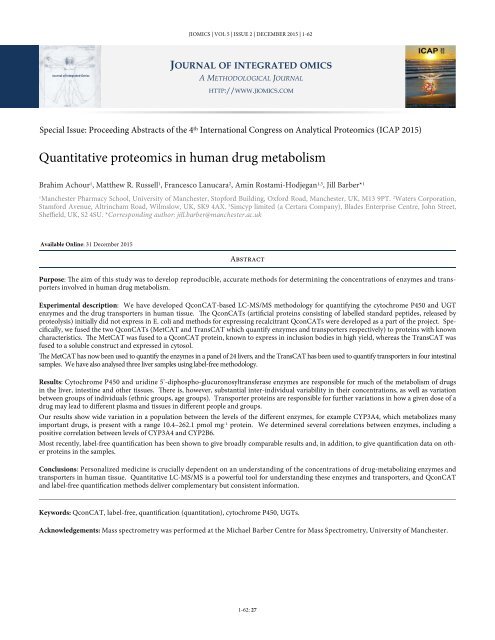JIOMICS
JIOMICS Internacional
JIOMICS Internacional
Create successful ePaper yourself
Turn your PDF publications into a flip-book with our unique Google optimized e-Paper software.
<strong>JIOMICS</strong> | VOL 5 | ISSUE 2 | DECEMBER 2015 | 1-62<br />
JOURNAL OF INTEGRATED OMICS<br />
Journal of Integrated Omics<br />
A METHODOLOGICAL JOURNAL<br />
HTTP://WWW.<strong>JIOMICS</strong>.COM<br />
Special Issue: Proceeding Abstracts of the 4 th International Congress on Analytical Proteomics (ICAP 2015)<br />
Quantitative proteomics in human drug metabolism<br />
Brahim Achour 1 , Matthew R. Russell 1 , Francesco Lanucara 2 , Amin Rostami-Hodjegan 1,3 , Jill Barber* 1<br />
1<br />
Manchester Pharmacy School, University of Manchester, Stopford Building, Oxford Road, Manchester, UK, M13 9PT. 2 Waters Corporation,<br />
Stamford Avenue, Altrincham Road, Wilmslow, UK, SK9 4AX. 3 Simcyp limited (a Certara Company), Blades Enterprise Centre, John Street,<br />
Sheffield, UK, S2 4SU. *Corresponding author: jill.barber@manchester.ac.uk<br />
Available Online: 31 December 2015<br />
Abstract<br />
Purpose: The aim of this study was to develop reproducible, accurate methods for determining the concentrations of enzymes and transporters<br />
involved in human drug metabolism.<br />
Experimental description: We have developed QconCAT-based LC-MS/MS methodology for quantifying the cytochrome P450 and UGT<br />
enzymes and the drug transporters in human tissue. The QconCATs (artificial proteins consisting of labelled standard peptides, released by<br />
proteolysis) initially did not express in E. coli and methods for expressing recalcitrant QconCATs were developed as a part of the project. Specifically,<br />
we fused the two QconCATs (MetCAT and TransCAT which quantify enzymes and transporters respectively) to proteins with known<br />
characteristics. The MetCAT was fused to a QconCAT protein, known to express in inclusion bodies in high yield, whereas the TransCAT was<br />
fused to a soluble construct and expressed in cytosol.<br />
The MetCAT has now been used to quantify the enzymes in a panel of 24 livers, and the TransCAT has been used to quantify transporters in four intestinal<br />
samples. We have also analysed three liver samples using label-free methodology.<br />
Results: Cytochrome P450 and uridine 5'-diphospho-glucuronosyltransferase enzymes are responsible for much of the metabolism of drugs<br />
in the liver, intestine and other tissues. There is, however, substantial inter-individual variability in their concentrations, as well as variation<br />
between groups of individuals (ethnic groups, age groups). Transporter proteins are responsible for further variations in how a given dose of a<br />
drug may lead to different plasma and tissues in different people and groups.<br />
Our results show wide variation in a population between the levels of the different enzymes, for example CYP3A4, which metabolizes many<br />
important drugs, is present with a range 10.4–262.1 pmol mg -1 protein. We determined several correlations between enzymes, including a<br />
positive correlation between levels of CYP3A4 and CYP2B6.<br />
Most recently, label-free quantification has been shown to give broadly comparable results and, in addition, to give quantification data on other<br />
proteins in the samples.<br />
Conclusions: Personalized medicine is crucially dependent on an understanding of the concentrations of drug-metabolizing enzymes and<br />
transporters in human tissue. Quantitative LC-MS/MS is a powerful tool for understanding these enzymes and transporters, and QconCAT<br />
and label-free quantification methods deliver complementary but consistent information.<br />
Keywords: QconCAT, label-free, quantification (quantitation), cytochrome P450, UGTs.<br />
Acknowledgements: Mass spectrometry was performed at the Michael Barber Centre for Mass Spectrometry, University of Manchester.<br />
1-62: 27


